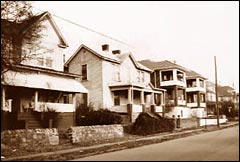
Lined with rundown, century-old houses and situated within a couple miles of downtown Roanoke, the neighborhood of Gainsboro, Va., seems an unlikely place to hatch a groundbreaking architectural experiment. But in early November, construction will begin there on the first cradle-to-cradle house, with those behind the project hoping to show that green can be affordable.
In many ways, Gainsboro is the perfect site for such an undertaking. After suffering years of deterioration and failed urban-renewal efforts, the city’s oldest neighborhood had been targeted by municipal leaders for sprucing up. Then, in 2004, local architects Gregg Lewis and Jennifer Smith Lewis, of SmithLewis Architecture, suggested the C2C concept for a housing design competition. By the end of the year, more than 600 submissions from 41 countries had flooded the SmithLewis office.
Designers were guided by a list of five issues that summed up the sustainability principles defined by architect William McDonough and chemist Michael Braungart in their 2002 book, Cradle to Cradle: Remaking the Way We Make Things. In addition to finding ways to eliminate construction waste and adapt natural energy systems, the list included “celebrating context” — the seamless integration of a C2C house into any type of neighborhood.
After all the entries were sorted through, a Seattle-based team led by architects Matthew Coates and Tim Meldrum was awarded first place. However, though the pair’s L-shaped, concrete-and-steel C2C concept was visually stunning and technologically sophisticated, the C2C organizers (now an official nonprofit organization called C2C Home) knew it wouldn’t fly in a conventional neighborhood like Gainsboro. So they looked for an alternate — an unassuming design that would fit the bill. And they found it in the work of two local architects.

The cradle-to-cradle house will blend right in to Gainsboro’s classic streets.
Photo: Virginia Department of Historic Resources
The local connection “was not intentional,” explains Nell Boyle, C2C Home assistant director. She says the house designed by Richard Rife and Stephen Feather is just more appropriate for the community. “[Gainsboro residents] expressed their concern that the house look like the others on the street. And affordability was another factor. This is a low- to middle-class neighborhood.”
Unlike the winning entry, which introduces a new model for living, the Rife and Feather design is a traditional, pitched-roof Southern home that has been reproduced nationwide for hundreds of years. “We took the basic ideas from C2C and incorporated features that are common around this area,” says Feather, a staff architect at the Interactive Design Group in Roanoke.
The result is a house that conjures images of mom and apple pie, backyard barbecues and front porch swings. There is nothing about this house that says “gray water treatment happens here.”
And that’s exactly the point, says Boyle. What C2C Home organizers hope to achieve in Gainsboro is to associate sustainability with affordability and tradition. “We want to show that a green home doesn’t need to cost more or look different from its neighbors.”
After mortgage incentives and product donations, the estimated cost of the house hovers around $95,000, within the ballpark of the median home price in Roanoke.
Passersby will not be able to distinguish the 1,602 square foot C2C house from others lining the block, nor will they know that the structure is completely modular, Boyle says. Local manufacturer Southern Heritage Homes created custom boxes of sustainably harvested wood in three sizes to be dropped onto the site and arranged to fit the two-story floor plan. After being nailed and screwed together, the modules will be finished with Hardiplank fiber cement board siding and shakes for a familiar “homey” effect.
The modules offer adaptability, significant decreases in construction waste, and reduced building costs, all C2C principles. The homeowner will likely see a savings in energy and water bills as well: the metal roof is coated to maintain comfortable interior temperatures, recycled pickle barrels will catch rainwater for irrigation, and low-flush toilets and energy-efficient appliances are part of the package. In addition, all paints, stains, carpet, cabinetry, and tiles contain no or low volatile organic compounds (VOCs), cutting back on that “new house smell.”
The C2C competition has generated a local movement of sorts that Boyle believes will gather momentum with the completion of the inaugural Gainsboro house. In Roanoke alone there are plans to build several more C2C homes, including the more futuristic design by Coates and Meldrum.
“Right now, the hurdles are overcoming the misconceptions and the notion that things can’t be done in a different way and still be affordable,” says Coates. “We’re showing that it is possible for the average person to create a more sustainable lifestyle.”

